Description of the farm
The respiratory disease process described in this clinical case affected the weaned piglets of a 1,050 sow farm located in Catalonia, Spain.

The health program of the farm is as follows:
- Live vaccine against Aujeszky to all the herd 3 times a year.
- Live vaccine against PRRS to all the herd 3 times a year.
- Bacterin against E. coli + clostridium at 60 and 90 of gestation in gilts, and at 90 days of gestation in multiparous sows.
- Bacterin against parvovirus and erysipelas after farrowing.
- Deworming and external deparasitization with an injectable ivermectin before farrowing.
The piglets are vaccinated against mycoplasma before they are weaned (at 19-20 days of age), and against PCV-2 at 5 weeks of age.
There are 3 different nursery sites:
- Barn A with space for 2,200 piglets and located 300 meters away from the sows' farm.
- Barn B with space for 1,000 piglets and located 50 km away from the sows' farm.
- Barn C with space for 1,200 piglets and located 70 km away from the sows' farm.
Each of the nursery barns has several rooms with space for 150 to 300 piglets. The three buildings are filled consecutively, carrying out an all-in-all-out by room, but not by building.
The farm operates with a one-week batch system, and the piglets are weaned at 3 weeks of age.
Status before the respiratory outbreak
The farm had remained stable for PRRS during the past 12 months, the virus was not present in the weaned piglets and they left the nursery serologically negative.
The total nursery mortality in the period previous to the appearance of the problem was mainly due to some sporadic cases of diarrhea caused by E.coli and exudative epidermitis cases in some of the batches, and to lightweight piglets that failed to thrive and adapt to the new diet.
Appearance of the clinical case
In August there was a cough outbreak in the 8-9 week old piglets in the nursery barn A. Apparently, it looked like a "normal" outbreak, that could be solved after a few days of antibiotic medication (doxycycline) in the water, but the truth is that on this case the pigs did not respond to the treatment.
During the following weeks the same signs appeared in other batches of piglets when they reached that age. The symptoms were always the same, although as weeks went by they became more and more serious: the pigs started to cough, dyspnea also appeared (some of them with a temperature higher than 40ºC), and the feed intake dropped.
Different antibiotic treatments were used (doxycycline, amoxicillin, sulfonamides + trimethoprim, macrolides) in the drinking water, as well as florfenicol in the feed. None of them had any effect on the appearance of the disease, and they were unable to reduce their intensity or duration.
The use of an oral non-steroidal anti-inflammatory drug (ketoprofen) did improve the general health condition, but the disease process lasted, anyway for 10-15 days in the different batches of animals.

The appearance of the disease was not linked to the nursery barn, because it appeared indistinctly in the three different nursery farms.
Evolution
During the two next months (September and October 2012), the same cough and dyspnea episodes recurred with two peculiarities:
1. Younger pigs were affected each time, with the problems starting on the week after weaning (4 weeks of age). Some of the affected animals suffered a serious respiratory difficulty and ended being very thin, as it is shown in the following video.
In the necropsies performed at the farm we found lungs with serious consolidation lesions, generally with a cranial-ventral distribution, but on other occasions, as in the case of images 1 and 2, they were distributed along the whole of the lung.
Apart from the lung lesions we did not find any other affected organs.
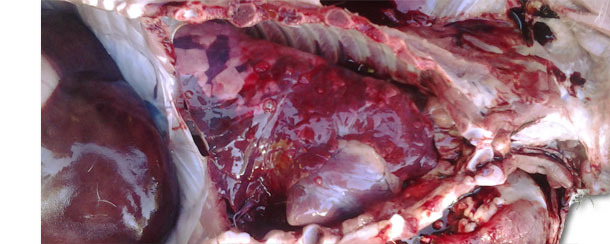
Image 1. Lung consolidation
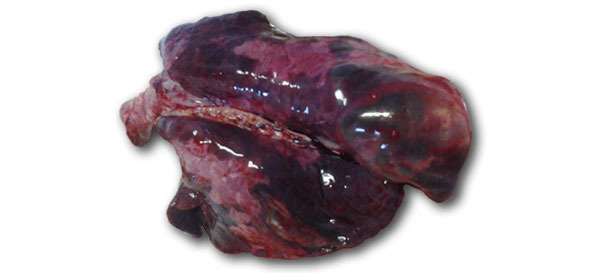
Image 2. Lung consolidation and emphysema in a piglet that died at the farm at 5 weeks of age.
2. Apart from the respiratory disease episode, the cases of animals with arthritis, lameness, and sudden deaths increased heavily, and they became 40% of the losses in some of the batches.
The necropsy of these animals showed polyserositis lesions compatible with Glässer's disease.
As a matter of fact, the mortality associated with this process was due more to the pigs with this "secondary" pathology than to those with the respiratory disease itself.
If we compare the nursery mortality of the period previous to the clinical case with the one registered during the respiratory outbreak it increased from 2.3% to 2.7%.
Since mid-September it was decided to inject tildipirosin to all the piglets at 4 weeks of age. With this medication we partly reduced the associated mortality, although it had no effect on the appearance of the respiratory problem.
Situation in the sows' farm
Between September and December, in coincidence with the respiratory problem, there was an increase in the abortions, as it is shown in the following graph:
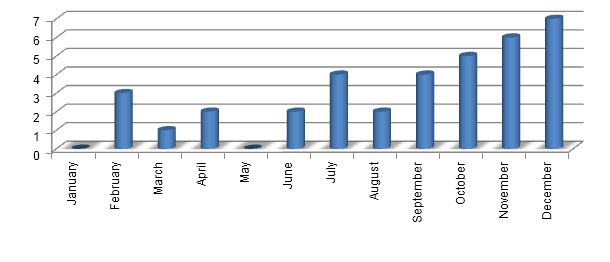
Graph 1. Monthly abortions in year 2012.
We did not relate in any moment the abortions with the problem suffered by the piglets. No other parameter (stillborn piglets, mortality during the lactation) was affected, and no other respiratory problem was seen, as well as no decrease in the consumption of feed in the sows nor in the nursing piglets.
Diagnosis
1- First attempt
1.1 Sending live piglets to a laboratory
On September 12th 2012, during the visit to the nursery barn B we saw that the 4-5 week old piglets started to cough. Many of them had dyspnea and were listless.
Two piglets were selected in order to not receive the antibiotic treatment, and on September 14th 2012 they were sent to the laboratory.
The necropsy report read: “a bilateral cranial-ventral lung consolidation that affects the whole of the apical and middle lobes, and the cranial third of the diaphragmatic and the accessory lobes. When cross-sectioned, the lungs do not ooze evident purulent material". In photograph 3 we see one of the two lungs:
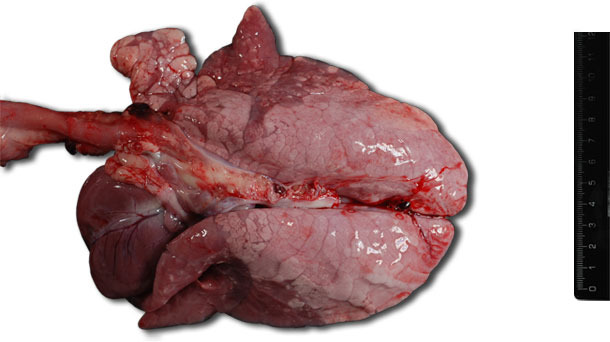
Image 3. Cranial-ventral lung consolidation
The anatomopathological study found an “intense subacute interstitial pneumonia with catarrhal-purulent bronchopneumonia. The rest of the organs did not present any kind of lesions.”
Both lungs were negative by PCR for PRRS virus.
One set of lungs was positive for swine influenza with the immunoperoxidase technique, and the other one was negative.
There was not a significant bacterial growth in the seedings performed.
The laboratory report read: “The absence of lesions in the lymph nodes allowed to rule out a porcine circovirus. The positive result for influenza in a set of lungs could suggest the role of this germ in the disease, but the necropsy report highlighted that the epithelial lesion is not evident microscopically, so the role of the SIV in the disease cannot be ascertained.”
1.2- Serum profile
Simultaneously, a seroprofile was carried out in the nursery stage and the first phases of the fattening stage simultaneously. No seroconversion for PRRS nor influenza (SIV) was seen in the piglets after overcoming the respiratory disease process.
What did we have up to that moment?
The clinical profile that we had made us suspect, clearly, of a viral disease:
- The clinical profile and the laboratory results rule out porcine circovirus.
- The absence of symptomatology in the sows and the results obtained up to that moment allowed to rule out, initially, PRRS virus.
- The symptoms were compatible with a SIV problem, but until that moment the results of the analyses were contradictory.
We decided to carry out more tests:
2- Second attempt
2.1 Quick test for the detection of the SIV at the farm
We carried out a test that allows the detection of the SIV at the farm from nasal swabs. We chose 5 four week old piglets from the weaners stage building B that showed the typical signs of the disease. Two of the 5 animals had a temperature of 40.3 ºC.
The result of the test was negative.
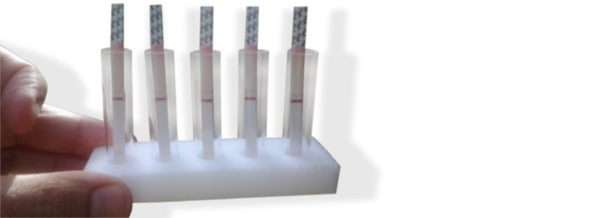
Image 4. Quick test for the detection of the SIV at the farm
2.2 New sending of 7 week old ill piglets to the laboratory
On October 3rd 2012 we sent 4 piglets from the weaners stage building C to the laboratory.
The results were as follows:
Necropsy report: “The animals sent show pleuritis, pericarditis and fibrinous peritonitis. Two of them show, also, absence of collapse, edema and disseminated pneumonia foci over the lung parenchyma. An accumulation of serous fluid in the thoracic cavity is seen in one of the animals. No other lesions are seen.”
Molecular diagnosis:
- SIV in bronchus and lung: negative.
- Mycoplasma hyopneumoniae in lung and bronchus: positive.
- PRRS in bronchus, lung and tonsil: negative.
These results were very shocking. We still did not have an etiologic agent that was the cause of the problem.
We did not give much importance to the presence of Mycoplasma hyopneumoniae in a set of lungs. We knew that the farm is positive for this pathogen, and that the animals had been vaccinated, but it is known that the vaccine does not exclude the possibility of an infection.
We had to go on with our search.
3- Definitive diagnosis
3.1 Lungs sent to the laboratory
On October 23rd 2012 we were told that in the nursery barn A 9 piglets died few minutes after the vaccination against circovirus.
When visiting the farm we saw that, as every week, at 10-12 days after the weaning the piglets were vaccinated against circovirus, and they were injected tildipirosin. There had never been any problems, but on this occasion out of 390 injected piglets 9 died.
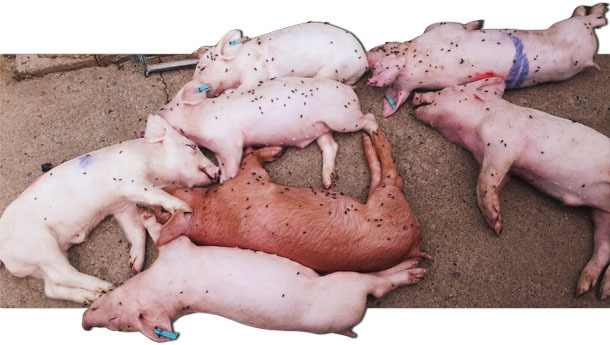
Image 5. Piglets dead at 10-12 days after their weaning
When observing the rest of the batch of piglets and taking their temperature we deduced that these piglets were at the initial stage of their respiratory disease outbreak and the farmer had not noticed it. When vaccinating them in this condition some of them died.
We sent the lungs of two of the dead animals to the laboratory.
On November 7th the results were notified to us: the two sets of lungs were positive for SIV using the PCR technique.
3.2- Oral fluids
On November 6th, another batch of animals started to show the usual problems when reaching 4 weeks of age.
As we had not received the results of the previous lungs yet, we decided to take oral fluids samples:
In 3 pens (25 piglets in each of them) we hanged cotton ropes for some 30 minutes to allow the piglets to bite them. After that we squeezed the ropes and we collected the oral fluids. We did not obtain enough fluids from one of the three ropes. We sent samples of the other 2 ropes and the result was positive for SIV by PCR.
Treatment and final conclusions
It seems clear that the SIV was the etiologic agent of this respiratory disease clinical profile in piglets in the weaners stage.
It was decided to vaccinate the whole sow herd with a trivalent influenza vaccine, because the appearance was too early to consider a vaccination of the piglets.
A mass vaccination of all the herd was performed on December 21st 2012, and a revaccination was carried out 3 weeks later.
Currently, the respiratory problems in the weaners stage have disappeared. The arthritis and sudden deaths associated problems have also dropped markedly.
During the next weeks we will stop the preventative injectable treatment with tildipirosin.
With respect to the solution of this case, I still have some questions for which I have not found the answer yet:
- The respiratory disease clinical profile began to improve even before of the arrival of the piglets born to the vaccinated and revaccinated sows. Was there a "self-immunization" of the sows with the field virus and so an increase in the passive immunity of the piglets?
- Why didn't we isolate any secondary germ (H. parasuis, P. multocida, ...) from the different samples sent to the laboratory?
- Watching at the evolution of the abortions, had they something to do with the SIV?
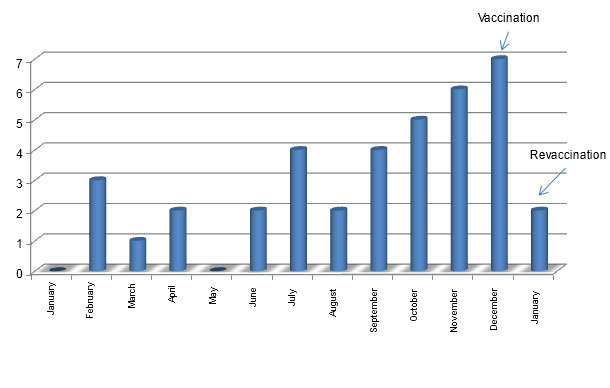
Graph 2. Monthly abortions from January 2012 to January 2013




